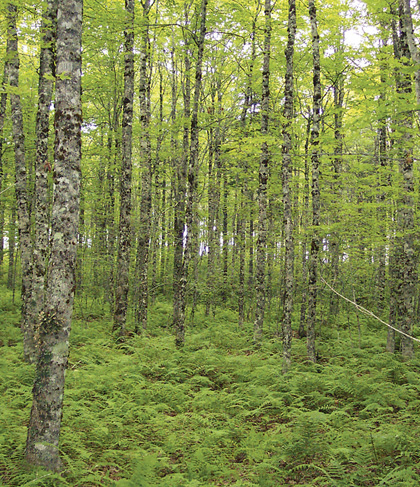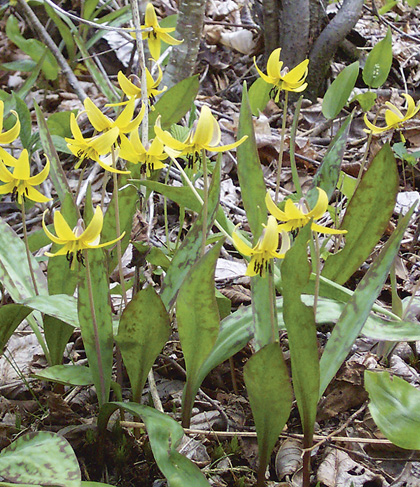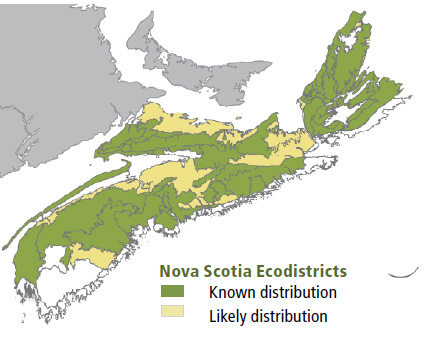
Forest Vegetation types - TH1
TH1 — Sugar maple / Hay-scented fern
Acer saccharum / Dennstaedtia punctilobula
TH1a — Beech variant
Fagus grandifolia
TH1b — Yellow birch variant
Betula alleghaniensis
 |
| Lake Alma, Annapolis County |
Concept: This late successional Vegetation Type (VT) has an overstory dominated by sugar maple and yellow birch, accompanied by a mix of mostly shade-tolerant trees. It is similar to TH2 (Sugar maple / New York fern – Northern beech fern), but is generally associated with drier and/or slightly less fertile sites. There are two variants: TH1a, where beech is abundant in both the overstory and understory; and TH1b, where yellow birch is dominant in the overstory. Due to the long-lived and shade-tolerant nature of dominant overstory trees, this VT will develop old forest characteristics maintained by gap disturbance. TH1 is one of several Acadian hardwood VTs found on zonal sites throughout Nova Scotia.
Vegetation: Sugar maple, yellow birch and beech are the dominant overstory trees (in various combinations) with lesser red maple and scattered red spruce and white spruce. The shrub layer contains regenerating tree species along with striped maple, fly-honeysuckle and mountain maple. Beech and/or striped maple coverage in this layer can sometimes be extensive, strongly out-competing other species. Herb coverage is diverse, but generally dominated by hay-scented fern and evergreen wood fern. Other common species may include rose twisted stalk, Indian cucumber root, wood sorrel, drooping wood sedge and wood aster. Spring ephemerals may include spring-beauty, Dutchman's-breeches and dog tooth violet. The bryophyte layer is poorly developed, with moss cover generally restricted to tree trunks, stones and downed woody material.
Environmental Setting: TH1 is mainly associated with dry to fresh-moist, nutrient medium to rich soils of glacial origin. This VT is found throughout the province in the Cobequid Hills, North Mountain and Cape Breton Hills ecodistricts, and on the upper slopes of drumlins. However, TH1 is relatively uncommon on the lowland ecodistricts and does not occur in the Atlantic coastal ecoregion. The variant TH1a (Beech) usually occurs on drier sites, while TH1b (Yellow birch) is associated with moister conditions. It is widespread and abundant across New Brunswick but somewhat rare on Prince Edward Island.
Successional Dynamics: TH1 is a late successional, uneven-aged climatic climax VT dominated by shade-tolerant hardwood. Excluding harvesting, stand level disturbance events are rare, with gaps or small patches usually created by individual tree mortality, wind or ice damage. Following stand level disturbance, TH1 can develop from early and mid-successional VTs including IH3 (Large-tooth aspen / Christmas fern – New York fern), IH5 (Trembling aspen – White ash / Beaked hazelnut /Christmas fern), IH7 (Red maple / Hay-scented fern – Wood sorrel), TH7 (Yellow birch – White birch / Evergreen wood fern) and TH8 (Red maple – Yellow birch / Evergreen wood fern). Early successional stages can be by-passed if, at the time of disturbance, advanced sugar maple and yellow birch regeneration is retained.
Ecological Features: This matrix forest typically occurs over hundreds of hectares. The longevity, shade tolerance and deep roots of sugar maple and beech promote stand continuity, high old-growth potential and uneven age structure. Stands on high elevation (greater than 200 m) crests and upper slopes are exposed to strong winds and are susceptible to ice storms, blowdown and crown breakage. Vernal pools, seeps and springs are common and may provide habitat for several amphibians (e.g. wood frogs). This forest may provide habitat for warblers, thrushes, woodpeckers, flying squirrels and fishers. Large trees may provide nest sites for barred owls and northern goshawks. Downed coarse woody debris may provide cover for red-backed salamanders and small mammals. Hard mast from beech and beaked hazelnut provides a significant food source for bears and other fauna. These forests host a variety of spring ephemeral plants. With increased light availability caused by canopy disturbances, hay-scented fern can be very invasive and spread aggressively, which restricts tree regeneration.
 |
| Dog tooth violet |
Distinguishing Features: This is a hardwood forest dominated by sugar maple usually found on well drained soils on upper slopes. Hay-scented fern is usually present in quantity. Beech is abundant in TH1a and yellow birch is dominant in TH1b. Rose twisted stalk and three species of wood ferns are common.
| Slope Position: | Upper5 Level2 Middle2 Other1 |
Surface Stoniness: |
(Non - Slightly)5 (Moderately)4 (Very - Excessively)1 |
Bedrock Outcrop: |
(Non-rocky)9 (Slightly - Moderately)1 |
Elevation Range: |
22 - 337m |
Slope Gradient: |
Gentle4 Level2 Steep2 Moderate1 nd1 |
Aspect: |
North3 East2 South1 West2 None2 |
Exposure: |
Mod. exposed4 Moderate3 Exposed2 Other1 |
Microtopography: |
Strongly4 Moderately4 Slightly1 Other1 |
Drainage: |
Well6 Moderately well3 Other1 |
Soil Type: |
ST2-L4 ST23 ST81 Other2 |
Parent Material: |
Glacial till8 Till/Bedrock1 Other1 |
Rooting Depth (cm): |
(<30)1 (30-45)3 (>45)5 nd1 |
Duff Thickness (cm): |
(0-5)3 (6-10)4 (11-20)2 nd1 |

